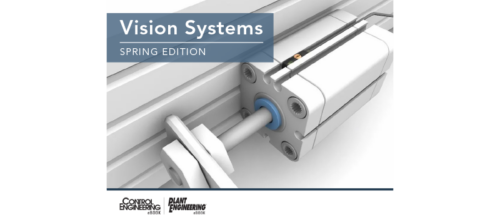Vision: Molecules, inspection/remote sensing, smart industrial sensors
New readers for barcode and 2D direct part marks, more powerful vision sensors, smart cameras, and molecular-level inspection are among recent developments from Cognex, Dalsa, DVT, Jai Pulnix, Microscan, and Pentek.
New readers for barcode and 2D direct part marks, more powerful vision sensors, smart cameras, and molecular-level inspection are among recent developments from Cognex, Dalsa, DVT, Jai Pulnix, Microscan, and Pentek. In addition, learn how vision systems and sonic technology have teamed to fight crime.
Cognex In-Sight 5400, said to be a very high performance vision sensor, has rugged design.
Handheld barcode/2D reader reads direct part marks: MS-Q Quadrus Imagers are optimized to read bar codes and 2D symbols that use direct part mark (DPM) methods. It is the most aggressive handheld imager available for decoding symbols on low contrast substrates (metal, plastic, rubber, and glass) with marking methods such as dot peen and laser/chemical etch. Containing custom optics and Microscan’s Quadrus decode algorithms, the MS-Q Quadrus combines the power of Microscan’s popular smart camera Quadrus EZ into a portable handheld device. Read more from Microscan .
Industrial vision sensors have four times the power: Cognex Corp. expanded its family of In-Sight vision sensors with the In-Sight 5100 and the In-Sight 5400. They have four times the processing power of comparably priced vision sensors and a rugged industrial design, and “set a new industry standard for machine vision,” Cognex says. They meet IEC specifications for shock and vibration and achieve an IP67 (NEMA 6) rating for dust and wash-down protection. “These are true industrial-grade vision sensors that can be deployed virtually anywhere on the factory floor,” said Jim Hoffmaster, CEO for Cognex. In addition to powerful processing, each acquires up to 60 full frames per second. When a full image is not required, even higher speeds are possible using partial acquisition. Read more from Cognex .
DVT is offering an Ethernet I/O assembly, industrial power supply, and intelligent breakout board to provide a more complete industrial machine vision solution.
More complete line, free vision software, conference: DVT is marketing three new products—an Ethernet I/O assembly, an industrial power supply, and an intelligent breakout board—that complement the company’s line of Legend family of machine vision systems and provide a more complete industrial machine vision solution. “As more manufacturers adopt machine vision, they want a vision system that is easy to integrate and constitutes a total vision solution from one vendor,” said Bob Steinke, DVT chairman and CEO. In other product news, DVT’s FrameWork 2.7 is the newest release of its free Microsoft Windows-based machine vision software, compatible with all Legend series machine vision systems and is backward compatible with older DVT systems. Highly enhanced reader capabilities take advantage of the new Texas Instruments DSP processor, which is standard in the DVT 550 series of Legend SmartImage sensors.
DVT also announced that the J.W. Marriott in Summerlin, NV (near Las Vegas) will be the site of the DVT 2004 Global Business Conference and User Group Meeting (GBC), Sept. 12-16. Program details and registration information are available from DVT here . New business unit covers smart cameras: Jai Pulnix Inc., a supplier of industrial-grade cameras, formed a new business unit to focus on the rapidly growing “smart camera” market. “Zero Instruction Set Computer” or ZISC, smart camera technology and chips were developed by IBM in cooperation with Silicon Recognition Inc. Jai Pulnix has two offerings in this product area: monochromatic ZiCAM (Zi-640) and a color version (ZiC-640). Read more from Jai Pulnix Smart Camera unit .
Separately, Jai Pulnix introduced the TM-6760 series, the newest in a line of AccuPiXEL cameras, which “feature an exceptionally small footprint and a highly configurable modular design,” with 60-frames-per second capture at full resolution. Thinking small: Pentek, Inc., provider of VME board-level technology, was selected to provide a DSP (digital signal processing) platform for the by the University of Washington’s adaptive cantilever control system that can study molecular structures at resolutions better than 1 Angstrom (10-10 m) in situ. Three identical controller and diagnostic systems will be used for 3-dimensional MRFM in the future. DSPCon, a Pentek integration partner, was responsible for the custom software development, integration and testing of the system. Read more from Pentek . Wafer inspection and remote sensing: Dalsa Corp. Application Specific Contracts (ASC) group received two custom camera contracts totaling $2.5 million. For one, Dalsa will produce a custom image sensor and digital camera to inspect semiconductor wafers at extremely high speeds and low light levels, enabling semiconductor wafer manufacturers to maintain better quality control, improve yield, and reduce costs. For the other, a custom camera will be part of a sophisticated imaging system for remote sensing, often used for monitoring crops, comparing urban and rural land use, tracking icebergs, detecting oil spills, and making maps, and nautical charts. Read more from Dalsa . Non-industrial vision application: cameras and sonic sensors fight crime in Chicago, funded by about $2.8 million in confiscated drug money. Chicago police installed 50 vision and sonic sensors with wireless data feeds to software that records images and triangulates input to alarm location of gunshots within 20 ft. Thirty already installed cameras will be upgraded with the gunshot-detection technology. Unlike industrial applications of similar technologies, operators (officers) reportedly get a refresher course in applicable language in the U.S. Constitution to help ensure appropriate use. There must be an industrial application someplace waiting for this combination of technologies. Read more on the urban application from WBBM News Radio 780 .
—Mark T. Hoske, Control Engineering editor in chief, MHoske@cfemedia.com
Do you have experience and expertise with the topics mentioned in this content? You should consider contributing to our CFE Media editorial team and getting the recognition you and your company deserve. Click here to start this process.


